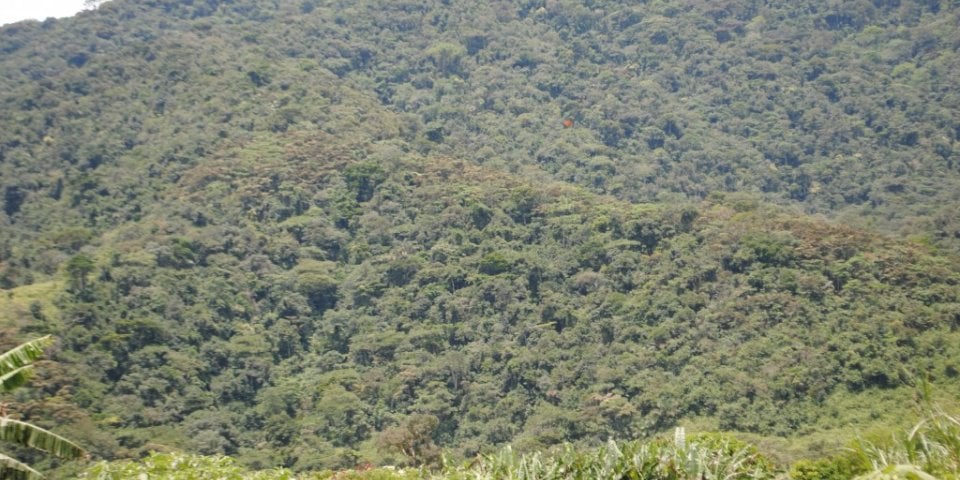The Itombwe Reserve in the Democratic Republic of Congo (DRC), one of Africa’s most biodiverse sites, had its boundaries formally approved recently by the Provincial Governor – a critical step in establishing and ensuring the effective protection of this important site.

The Itombwe’s natural reserve is a vast forest located in the province of South Kivu in the East of the DRC. It stretches over the communities of Itombwe, Wamuzimu, Tanganyika, and Lwindi. At least 53 globally threatened species are found in Itombwe/ Photo credit/WorldPulse
The move follows requests by SOS grantee, The Wildlife Conservation Society (WCS) and its partners to finalize the reserve’s establishment in order to conserve the Grauer’s gorilla (Gorilla beringei graueri) among other amazing species.
By DRC law, formal boundaries are needed to effectively work on the ground to protect the 2,213 square mile (5,732 square kilometer) reserve. The Itombwe reserve is one of the most biodiverse sites in Africa and to date 756 terrestrial vertebrates and 1,036 plant species have been documented.
The site has only been visited a few times by scientists and it is likely many more species will be found in the future. Of these known species, 108 are found only in the Albertine Rift region of Africa with several of these species found only in Itombwe, such as the Itombwe Golden Frog (Chrysobatrachus cupreonitens), the Itombwe or Prigogine’s nightjar (Caprimulgus prigoginei) and Schouteden’s swift (Schoutedenapus schoutedeni).
What is more, at least 53 globally threatened species are found in Itombwe, and several more are classified as Data Deficient because they are so rarely seen and described. Further, the Itombwe Massif was one of two sites that were identified by conservationists as critical for the protection of Grauer’s gorillas.
Following surveys of the massif in the mid-1990s and early 2000s, Itombwe Reserve was legally gazetted by a Ministerial decree in 2006. However, with no clear boundaries and without any consultations with local communities living there, conflict and a lack of jurisdiction left both people and wildlife vulnerable.

The city of Itombwe is hardly accessible by road, it is located 350Km from Bukavu, 200km from the city of ’Uvira, 110km from Baraka. Photo credit/SOS
WCS, working with its partners, conducted a consent-based consultation process with local communities in and around the new reserve. This led to locally-approved boundaries. “Itombwe is one of the most important sites for conservation in Africa and it is great news that the Government of DRC and the communities that live in the massif have finally fully established this unique protected area,” said SOS grantee Andy Plumptre of WCS’s Albertine Rift Program.
This gazetting process has taken over 10 years. In 2006 the Minister of Environment unilaterally gazetted the Reserve but apart from a rough map it had no boundaries described. Its creation without consultation with local communities caused a lot of friction. To address this, WCS obtained a grant from USAID, to help resolve these conflicts coming up with a process of engaging communities to identify the reserve boundaries.
Meanwhile, work by WCS on the several endemic and threatened amphibians and other species funded through SOS as well as US Fish and Wildlife Service helped better determine where the biological boundaries of the Reserve should be located.
Andy and his team used this to push for an extension to Mt. Mohi and the highlands in the east of the Reserve – which are critical for many of the endemic species. These places will be even more critical under climate change.
At the same time, others including CEPF funded WCS to work with communities around the reserve to identify the limits of the Reserve.
Now a process of zoning of the reserve is underway, which is critical to define with the communities where conservation, sustainable use and human development will take place within the Reserve.
Click here to read the original article.

I am very interested in this part of DRC which is believed to be my ancestral habitat from father’s side beside being a katangese. I live out of DRC but I would like to contribute much in tourism in that area once the country will be having peace and stability. My aim is to modernize the town of Baraka with so many luxury guest houses and also beatify the city of Itombwe. The move will attract many tourists in that region of Africa. There is a need of establishing a protected reserve of itombwe by placing specific lodging centres for tourists.
As a developer and economist consultant I will need partners and investors in the form of PPPP to realize my dream. We will involve big financial institutions to come on board and make itombwe a special destination for worldly tourism.